Microalga Broths Synthesize Antibacterial and Non-Cytotoxic Silver Nanoparticles Showing Synergy with Antibiotics and Bacterial ROS Induction and Can Be Reused for Successive AgNP Batches
- PMID: 38003373
- PMCID: PMC10670984
- DOI: 10.3390/ijms242216183
Microalga Broths Synthesize Antibacterial and Non-Cytotoxic Silver Nanoparticles Showing Synergy with Antibiotics and Bacterial ROS Induction and Can Be Reused for Successive AgNP Batches
Abstract
The era of increasing bacterial antibiotic resistance requires new approaches to fight infections. With this purpose, silver-based nanomaterials are a reality in some fields and promise new developments. We report the green synthesis of silver nanoparticles (AgNPs) using culture broths from a microalga. Broths from two media, with different compositions and pHs and sampled at two growth phases, produced eight AgNP types. Nanoparticles harvested after several synthesis periods showed differences in antibacterial activity and stability. Moreover, an evaluation of the broths for several consecutive syntheses did not find relevant kinetics or activity differences until the third round. Physicochemical characteristics of the AgNPs (core and hydrodynamic sizes, Z-potential, crystallinity, and corona composition) were determined, observing differences depending on the broths used. AgNPs showed good antibacterial activity at concentrations producing no or low cytotoxicity on cultured eukaryotic cells. All the AgNPs had high levels of synergy against Escherichia coli and Staphylococcus aureus with the classic antibiotics streptomycin and kanamycin, but with ampicillin only against S. aureus and tetracycline against E. coli. Differences in the synergy levels were also dependent on the types of AgNPs. We also found that, for some AgNPs, the killing of bacteria started before the massive accumulation of ROS.
Keywords: AgNPs from recycled broths; ROS production; Tinto River; acid-tolerant; antibacterial activity; antibacterial synergistic activity; cytotoxicity; green synthesis; microalgae; silver nanoparticles.
Conflict of interest statement
The authors declare no conflict of interest.
Figures

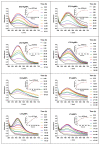
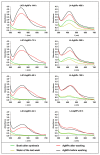



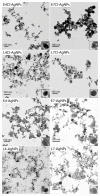

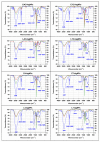
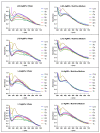
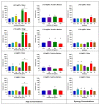

Similar articles
-
Silver Nanoparticles (AgNPs) from Lysinibacillus sp. Culture Broths: Antibacterial Activity, Mechanism Insights, and Synergy with Classical Antibiotics.Biomolecules. 2025 May 16;15(5):731. doi: 10.3390/biom15050731. Biomolecules. 2025. PMID: 40427624 Free PMC article.
-
Green Extracellular Synthesis of Silver Nanoparticles by Pseudomonas alloputida, Their Growth and Biofilm-Formation Inhibitory Activities and Synergic Behavior with Three Classical Antibiotics.Molecules. 2022 Nov 5;27(21):7589. doi: 10.3390/molecules27217589. Molecules. 2022. PMID: 36364415 Free PMC article.
-
Characterization and study of the antibacterial mechanisms of silver nanoparticles prepared with microalgal exopolysaccharides.Mater Sci Eng C Mater Biol Appl. 2019 Jun;99:685-695. doi: 10.1016/j.msec.2019.01.134. Epub 2019 Feb 1. Mater Sci Eng C Mater Biol Appl. 2019. PMID: 30889742
-
Nanocomposites: silver nanoparticles and bacteriocins obtained from lactic acid bacteria against multidrug-resistant Escherichia coli and Staphylococcus aureus.World J Microbiol Biotechnol. 2024 Oct 3;40(11):341. doi: 10.1007/s11274-024-04151-3. World J Microbiol Biotechnol. 2024. PMID: 39358621 Review.
-
Silver Nanoparticles and Their Antibacterial Applications.Int J Mol Sci. 2021 Jul 4;22(13):7202. doi: 10.3390/ijms22137202. Int J Mol Sci. 2021. PMID: 34281254 Free PMC article. Review.
Cited by
-
Harnessing Desmochloris edaphica Strain CCAP 6006/5 for the Eco-Friendly Synthesis of Silver Nanoparticles: Insights into the Anticancer and Antibacterial Efficacy.Molecules. 2024 Aug 7;29(16):3750. doi: 10.3390/molecules29163750. Molecules. 2024. PMID: 39202829 Free PMC article.
-
Silver Nanoparticles (AgNPs) from Lysinibacillus sp. Culture Broths: Antibacterial Activity, Mechanism Insights, and Synergy with Classical Antibiotics.Biomolecules. 2025 May 16;15(5):731. doi: 10.3390/biom15050731. Biomolecules. 2025. PMID: 40427624 Free PMC article.
References
-
- O’Neill J. Tackling Drug-Resistant Infections Globally: Final Report and Recommendations. HM Government and the Wellcome Trust; London, UK: 2016. The Review on Antimicrobial Resistance.
-
- Crisan C.M., Mocan T., Manolea M., Lasca L.I., Tăbăran F.-A., Mocan L. Review on Silver Nanoparticles as a Novel Class of Antibacterial Solutions. Appl. Sci. 2021;11:1120. doi: 10.3390/app11031120. - DOI
MeSH terms
Substances
LinkOut - more resources
Full Text Sources

